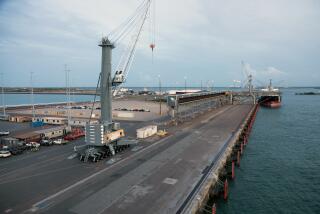Australian City Forges Multiethnic Links
- Share via
DARWIN, Australia — In the sticky heat of Australia’s northernmost city, Asia and Australia come face to face.
A political refugee from East Timor--taken over forcibly by Indonesia in 1975--stands beside an Indonesian businessman as he buys a green papaya salad from a food stall at a weekend market.
Nearby, Anglo Celtic Australians buy Asian herbs, fresh mangoes, casava root and rambutans grown in “Sam” Wilairat’s backyard. A resident since leaving Thailand three decades ago, she embodies Darwin’s reputation as Australia’s most multicultural and egalitarian city.
“I came to Darwin in 1965, got married and I’ve been here ever since,” she says. “I have three children. My daughter looks like a model--I’m Thai, my husband’s Hungarian, so she’s beautiful.”
As Australia struggles to shake off a British colonialist past steeped in racism and find acceptance from Asian neighbors, this city of just 95,000 people sees itself as the vanguard for the rest of the nation.
Closer to Indonesia’s capital than to any other Australian state capital and separated by the desolate outback from Australia’s main cities in the southeast, Darwin has forged a unique character as a frontier town closer in feel to parts of Asia than its southern cousins.
“Darwin is the most culturally diverse city in Australia,” says Shane Stone, chief minister of the Northern Territory, of which Darwin is capital.
Bigger and better known cities like Sydney and Canberra are “ethnocentric” and “never took up the challenge to embrace or engage the region,” he said.
His government is pursuing an $858-million proposal to link Darwin to the railways of southern Australia and is building a $60-million deep-water port. The plan is to make Darwin a bridge for Asian Australian trade.
Darwin became a permanent settlement in 1869 after three failed tries to settle the continent’s 3,000-mile north coast. It was named after Charles Darwin, the naturalist who traveled the region in 1836.
The city’s isolation is exacerbated by a harsh climate. It doesn’t rain for six months of the year, then monsoons turn dusty pastures into mosquito- and disease-ridden swamps. About 70 crocodiles are pulled each year from the harbor and suburban beaches, where you can’t swim anyway because of potentially deadly box jellyfish.
Darwin first became Australia’s link with the outside world in 1872 when an overland telegraph line was completed and joined a submarine cable connected to Java.
In the mid-1800s, Chinese laborers were imported to Australia’s north to build the telegraph and railroads. By 1890 Chinese outnumbered Europeans by 4 to 1. A gold rush and the discovery of pearl shell brought other migrants.
As the site of a big naval and air base, Darwin is the only Australian city to be attacked in wartime. In 1942, Japanese bombers struck several times, killing more than 240 people and forcing the evacuation of nearly all civilians.
On Christmas Day in 1974, Darwin was again almost destroyed when Cyclone Tracy tore through, destroying or damaging 90% of the buildings and killing 50 people.
But determined residents rebuilt, and Darwin now has among the highest economic and population growth rates in Australia. Underpinned by a strong military presence, the regional economy’s biggest industries are mining, ranching and tourism.
Darwinites pride themselves on their colorful history and their difference from the rest of Australia.
“Australians still come to Darwin and express amazement that we have got made roads, running water and electricity,” Stone says. “Southerners delight in referring to us as rednecks and cowboys. I rejoice in the rednecks and the cowboys of the north because they are the people that made it.”
These days, almost a quarter of Darwin’s population was born overseas, and about a quarter of those were born in Southeast Asia.
Although Asian immigration became a controversial topic last year after independent legislator Pauline Hanson claimed that the country was in danger of being “swamped,” Stone welcomes all comers as part of his government’s plan to make Darwin a trade and investment “gateway to Asia.”
“We don’t care whether you are pink, purple, black, brindle, whatever. If you want to compete on the same terms as anyone else, this is the place to be,” he says.
One group, the aborigines who have lived in the area for 50,000 years, do not agree. Aborigines make up a quarter of the Northern Territory’s population, but just 9% of Darwin’s, and aboriginal leaders are constantly at odds with Stone.
His conservative government opposes aborigine claims to limited rights to land in and around Darwin.
Stone recognizes aborigines’ contribution to Darwin’s culture, particularly in tourism, but they remain on society’s margins.
More to Read
Sign up for Essential California
The most important California stories and recommendations in your inbox every morning.
You may occasionally receive promotional content from the Los Angeles Times.












